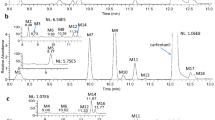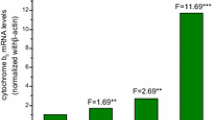Abstract
Background/aims
Cigarette smoking increases the risk of cancer of the pancreas. The tobacco-specific nitrosamine 4-(methylnitrosamino)-1-(3-pyridyl)-1-butanone (NNK) is the only known environmental compound that induces pancreatic cancer in laboratory animals. Concentrations of NNK are significantly higher in the pancreatic juice of smokers than in that of nonsmokers. The chiral NNK metabolite, (R,S)-4-(methylnitrosamino)-1-(3-pyridyl)-1-butanol (NNAL) is itself a potent pancreatic carcinogen in rats. The carcinogenicity of NNAL is related to its stereochemistry; (S)-NNAL is a more potent lung tumorigen in the A/J mouse than is (R)-NNAL. In this study, we determined the potential of the human pancreas to convert NNK into NNAL.
Materials and methods
Human pancreatic microsomes and cytosols were incubated with [5-3H]NNK, and the metabolic products were determined by high-performance liquid chromatography (HPLC).
Results
(S)-NNAL was the predominant isomer formed in all cytosolic incubations. In ten microsomal samples, NNAL was formed at an average rate of 3.8 ± 1.6 pmol/mg/min; (R)-NNAL was the predominant isomer in this group. The average rate of NNAL formation in 18 other microsomal samples was significantly lower, 0.13 ± 0.12 pmol/mg/min (p < 0.001); (S)-NNAL was the predominant isomer formed in this group.
Conclusion
In human pancreatic tissues, there is intraindividual variability regarding the capacity for, and stereoselectivity of, carbonyl reduction of NNK.





Similar content being viewed by others
Abbreviations
- 11β-HSD:
-
11β-hydroxysteroid dehydrogenase
- DTT:
-
dithiothreitol
- GA:
-
glycyrrhizic acid
- keto acid:
-
4-oxo-4-(3-pyridyl)-1-butanoic acid
- keto alcohol (HPB):
-
4-hydroxy-4-(3-pyridyl)-1-butanone
- (S)-MBIC:
-
(S)-(−)-(α)-methylbenzyl isocyanate
- NNAL:
-
4-(methylnitrosamino)-1-(3-pyridyl)-1-butanol
- NNAL-Gluc:
-
[4-(methylnitrosamino)-1-(3-pyridyl)but-1-yl]-β-O-d-glucosiduronic acid
- NNAL-MBIC:
-
[4-(methylnitrosamino)-1-(3-pyridyl)but-1-yl] N-(α-methylbenzyl) carbamate
- NNK:
-
4-(methylnitrosamino)-1-(3-pyridyl)-1-butanone
- PMSF:
-
phenylmethylsulfonyl fluoride
- TSNA:
-
tobacco-specific nitrosamines
References
Jemal A, Siegel R, Ward E, Murray T, Xu J, Smigal C, Thun MJ (2006) Cancer statistics, 2006. CA Cancer J Clin 56:106–130
Gallicchio L, Kouzis A, Genkinger JM, Burke AE, Hoffman SC, Diener-West M, Helzlsouer KJ, Comstock GW, Alberg AJ (2006) Active cigarette smoking, household passive smoke exposure, and the risk of developing pancreatic cancer. Prev Med 42:200–205
Shen M, Boffetta P, Olsen JH, Andersen A, Hemminki K, Pukkala E, Tracey E, Brewster DH, McBride ML, Pompe-Kirn V, Kliewer EV, Tonita JM, Chia KS, Martos C, Jonasson JG, Colin D, Scelo G, Brennan P (2006) A pooled analysis of second primary pancreatic cancer. Am J Epidemiol 163:502–511
Chiu BCH, Lynch CF, Cerhan JR, Cantor KP (2001) Cigarette smoking and risk of bladder, pancreas, kidney, and colorectal cancers in Iowa. Ann Epidemiol 11:28–37
Coughlin SS, Calle EE, Patel AV, Thun MJ (2000) Predictors of pancreatic cancer mortality among a large cohort of United States adults. Cancer Causes Control 11:915–923
Wynder EL, Mabuchi K, Maruchi N, Fortner JG (1973) A case control study of cancer of the pancreas. Cancer 31:641–648
Muscat JE, Stellman SD, Hoffmann D, Wynder EL (1997) Smoking and pancreatic cancer in men and women. Cancer Epidemiol Biomark Prev 6:15–19
Ghadirian P, Simard A, Baillargeon J (1991) Tobacco, alcohol, and coffee and cancer of the pancreas. A population-based, case control study in Quebec, Canada. Cancer 67:2664–2670
Kahn HA (1966) The Dorn study of smoking and mortality among U.S. veterans: report on eight and one-half years of observation. Natl Cancer Inst Monogr 19:1–125
Hoffmann D, Hoffmann I, El-Bayoumy K (2001) The less harmful cigarette: a controversial issue. A tribute to Ernst L. Wynder. Chem Res Toxicol 14:767–790
Hecht SS (1998) Biochemistry, biology, and carcinogenicity of tobacco-specific N-nitrosamines. Chem Res Toxicol 11:559–603
Hoffmann D, Rivenson A, Abbi R, Wynder EL (1993) A study of tobacco carcinogenesis: effect of the fat content of the diet on the carcinogenic activity of 4-(methylnitrosamino)-1-(3-pyridyl)-1-butanone in F344 rats. Cancer Res 53:2758–2761
Rivenson A, Hoffmann D, Prokopczyk B, Amin S, Hecht SS (1988) Induction of lung and exocrine pancreas tumors in F344 rats by tobacco-specific and Areca-derived N-nitrosamines. Cancer Res 48:6912–6917
Ouyang H, Mou L-j, Luk C, Liu N, Karaskova J, Squire J, Tsao M-S (2000) Immortal human pancreatic duct epithelial cell lines with near normal genotype and phenotype. Am J Pathol 157:1623–1631
Prokopczyk B, Hoffmann D, Bologna M, Cunningham AJ, Trushin N, Akerkar S, Boyiri T, Amin S, Desai D, Colosimo S, Pittman B, Leder G, Ramadani M, Henne-Bruns D, Beger HG, El-Bayoumy K (2002) Identification of tobacco-derived compounds in human pancreatic juice. Chem Res Toxicol 15:677–685
Hecht SS, Carmella SG, Murphy SE, Akerkar S, Brunnemann K, Hoffmann D (1993) A tobacco-specific lung carcinogen in the urine of men exposed to cigarette smoke. N Engl J Med 329:1543–1546
Carmella SG, Akerkar SA, Richie JP, Hecht SS (1995) Intraindividual and interindividual differences in metabolites of the tobacco-specific lung carcinogen 4-(methylnitrosamino)-1-(3-pyridyl)-1-butanone (NNK) in smokers’ urine. Cancer Epidemiol Biomark Prev 4:635–642
Upadhyaya P, Kenney PMJ, Hochalter JB, Wang M, Hecht SS (1999) Tumorigenicity and metabolism of 4-(methylnitrosamino)-1-(3-pyridyl)-1-butanol enantiomers and metabolites in the A/J mouse. Carcinogenesis 20:1577–1582
Staretz ME, Murphy SE, Patten CJ, Nunes MG, Koehl W, Amin S, Koenig LA, Guengerich FP, Hecht SS (1997) Comparative metabolism of the tobacco-related carcinogens benzo[a]pyrene, 4-(methylnitrosamino)-1-(3-pyridyl)-1-butanone, 4-(methylnitrosamino)-1-(3-pyridyl)-1-butanol and N′-nitrosonornicotine in human hepatic microsomes. Drug Metab Dispos 25:154–162
Chen CB, Hecht SS, Hoffmann D (1978) Metabolic α-hydroxylation of the tobacco-specific carcinogen, N′-nitrosonornicotine. Cancer Res 38:3639–3645
McKennis H, Schwartz SL, Turnbull LB, Tamaki E, Bowman ER (1964) Metabolic formation of gamma-(3-pyridyl)-gamma-hydroxybutyric acid and its possible intermediary role in mammalian metabolism of nicotine. J Biol Chem 239:3981–3989
Prokopczyk B, Trushin N, Leszczynska J, Waggoner SE, El-Bayoumy K (2001) Human cervical tissue metabolizes the tobacco-specific nitrosamine, 4-(methylnitrosamino)-1-(3-pyridyl)-1-butanone, via α-hydroxylation and carbonyl reduction pathways. Carcinogenesis 22:107–114
Smith TJ, Stoner GD, Yang CS (1995) Activation of 4-(methylnitrosamino)-1-(3-pyridyl)-1-butanone (NNK) in human lung microsomes by cytochromes P450, lipoxygenase, and hydroperoxides. Cancer Res 55:5566–5573
Hecht SS, Spratt TE, Trushin N (1997) Absolute configuration of 4-(methylnitrosamino)-1-(3-pyridyl)-1-butanol formed metabolically from 4-(methylnitrosamino)-1-(3-pyridyl)-1-butanone. Carcinogenesis 18:1851–1854
Hecht SS, Spratt TE, Trushin N (2000) Corrigendum: Absolute configuration of 4-(methylnitrosamino)-1-(3-pyridyl)-1-butanol formed metabolically from 4-(methylnitrosamino)-1-(3-pyridyl)-1-butanone. Carcinogenesis 20:850
Maser E (1998) 11β-Hydroxysteroid dehydrogenase responsible for carbonyl reduction of the tobacco-specific nitrosamine 4-(methylnitrosamino)-1-(3-pyridyl)-1-butanone in mouse lung microsomes. Cancer Res 58:2996–2303
Zimmerman CL, Wu Z, Upadhyaya P, Hecht SS (2004) Stereoselective metabolism and tissue retention in rats of the individual enantiomers of 4-(methylnitrosamino)-1-(3-pyridyl)-1-butanol (NNAL), metabolites of the tobacco-specific nitrosamine, 4-(methylnitrosamino)-1-(3-pyridyl)-1-butanone (NNK). Carcinogenesis 25:1237–1242
Lao YB, Yu NX, Kassie F, Villalta PW, Hecht SS (2007) Formation and accumulation of pyridyloxobutyl DNA adducts in F344 rats chronically treated with 4-(methylnitrosamino)-1-(3-pyridyl)-1-butanone and enantiomers of its metabolite, 4-(methylnitrosamino)-1-(3-pyridyl)-1-butanol. Chem Res Toxicol 20:235–245
Soldan M, Nagel G, Losekam M, Ernst M, Maser E (1999) Interindividual variability in the expression and NNK carbonyl reductase activity of 11β-hydroxysteroid dehydrogenase 1 in human lung. Cancer Lett 145:49–56
Anderson KE, Hammons GJ, Kadlubar FF, Potter JD, Kaderlik KR, Ilett KF, Minchin RF, Teitel CH, Chou HC, Martin MV, Guengerich FP, Barone GW, Lang NP, Peterson LA (1997) Metabolic activation of aromatic amines by human pancreas. Carcinogenesis 18:1085–1092
Prokopczyk B, Leder G, Trushin N, Cunningham AJ, Akerkar S, Pittman B, Ramadani M, Straeter J, Beger HG, Henne-Bruns D, El-Bayoumy K (2005) 4-Hydroxy-1-(3-pyridyl)-1-butanone, an indicator for 4-(methylnitrosamino)-1-(3-pyridyl)-1-butanone-induced DNA damage, is not detected in human pancreatic tissue. Cancer Epidemiol Biomark Prev 14:540–541
Author information
Authors and Affiliations
Corresponding author
Additional information
Neil Trushin and Gerhard Leder equally contributed to this work.
This work was supported by Public Health Service grant CA76228 from the National Cancer Institute, National Institute of Health, Department of Health and Human Services.
Rights and permissions
About this article
Cite this article
Trushin, N., Leder, G., El-Bayoumy, K. et al. The tobacco carcinogen NNK is stereoselectively reduced by human pancreatic microsomes and cytosols. Langenbecks Arch Surg 393, 571–579 (2008). https://doi.org/10.1007/s00423-007-0265-3
Received:
Accepted:
Published:
Issue Date:
DOI: https://doi.org/10.1007/s00423-007-0265-3




